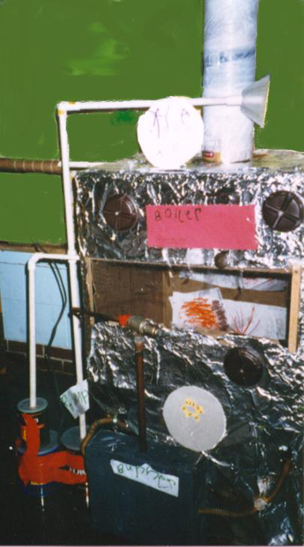Volume 2 Number 1
©The Author(s) 2000
Linking Standards and Engaged Learning in the Early Years
Abstract
Early childhood educators are increasingly concerned about the trend toward national standards and national testing. This article addresses issues of assessment in the early years of schooling, prekindergarten through third grade—a period when active, engaged, hands-on learning is most appropriate. Documentation of a kindergarten project on a turtle is presented to show how a science content standard is attained and how evidence is gathered that demonstrates the attainment of those skills inherent in the standard. The article then presents a framework for helping teachers and administrators to think about standards and the documentation of attainment of standards in ways that are compatible with how young children learn. The documentation procedures are especially compatible with approaches to learning that encourage student initiation and interest, such as the Project Approach.
Introduction
The early years of schooling are an important period of development. It is in prekindergarten through third grade that children learn to read and write, acquire a basic understanding of content areas, and develop important dispositions toward learning. It is also a time to begin the process of assessing children’s performance related to standards. Documenting the growth of young learners, however, presents many challenges. Traditional methods of assessment, such as standardized tests, which require single-answer responses within specified time frames, put enormous pressure on young learners. Pressure can inhibit thinking (Jensen, 1998) and decrease the accuracy of assessment. These traditional methods of assessment are also insufficiently sensitive to the ways young learners demonstrate their competencies. On-demand assessment can also interrupt the learning process in active, engaging classrooms. If standardized assessments require computerized grading and statistical analysis, the results are usually not immediately available to teachers. Results of these assessments often reach teachers too late for modification and redesign of learning experiences for the children who have been assessed.
In this article, we recommend a decision-making process for documenting children’s performance as it relates to standards in a way that is consistent with how young children demonstrate their knowledge and skills.
The Challenge of Young Learners
During the preschool years and early primary grades, children learn best through active, engaged, meaningful experiences. Through these experiences, young children construct their own knowledge by interacting with their environments and others. The work of Piaget has demonstrated the importance of sensory experiences and concrete learning activities (Labinowicz, 1980). The National Association for the Education of Young Children confirmed the importance of direct, firsthand, interactive experience in their position statement on developmentally appropriate practice in early childhood programs (Bredekamp, 1987; Bredekamp & Copple, 1997). These experiences are difficult to assess.
Insights from brain research suggest that learning is easier when experiences are interconnected rather than compartmentalized into narrow subject areas (Caine & Caine, 1997). Teaching strategies such as complex thematic units and the Project Approach (Katz & Chard, 1989), which are the framework for instruction in many early childhood classrooms, provide this integration and intellectual challenge. Children, especially in the early years of schooling, learn from these hands-on, thought-provoking experiences. Such experiences engage their curiosity, motivate them to apply their developing skills, and challenge children to think reflectively; but the outcomes of such experiences are difficult to assess.
The early years are also important for the development of positive dispositions toward learning as described by Bruner (1996), Katz (1987), and Smith (1990). When we are teaching the young child, we not only provide opportunities to learn knowledge and skills but also to develop attitudes and dispositions about the use of that knowledge and those skills. The disposition to read, for example, includes how a child feels about reading and whether or not the child wants to learn to read. A child with a positive disposition toward reading will choose to read often. The consequence of the positive disposition will be more opportunities to practice the skill of reading. Reading is one of many complex skills that improve with use, not just with instruction (L. G. Katz, personal communication, February 18, 2000). In this way, the development of dispositions becomes critical for the long-term attainment of high standards. Children’s development of dispositions, however, is a challenge to assess.
Standards and Young Children
Achievement of standards can be documented in active, engaged learning experiences. For example, here is a content standard from the National Science Education Standards (National Committee on Science Education Standards and Assessment, 1996):
Content Standards: K-4
Science as Inquiry
Content Standard A: As a result of activities in grades K-4, all students should develop
Abilities necessary to do scientific inquiry
Understanding about scientific inquiry
Guide to the content standard:
Fundamental abilities and concepts that underlie this standard include:
Abilities Necessary to Do Scientific InquiryAsk a question about objects, organisms and events in the environment. This aspect of the standard emphasizes students asking questions that they can answer with scientific knowledge, combined with their own observations. Students should answer their questions by seeking information from reliable sources of scientific information and from their own observations and investigations....
PLAN AND CONDUCT A SIMPLE INVESTIGATION. In the earliest years, investigations are largely based on systematic observations. As students develop, they may design and conduct simple experiments to answer questions.... (p. 122)
An example of children’s achieving this standard can be observed in an engaged learning experience—the Turtle Project in Linda Lundberg's kindergarten class at Parker Early Education Center in Machesney Park, Illinois (Helm & Katz, in press). This project began when a turtle named George was given to the class.
The children's words and drawings about what they were observing that are included here are taken from a documentation panel for the Turtle Project prepared by the teacher. For several months, the children had been caring for George, who had unexpectedly turned out to be a female turtle. In late November, the children noticed that George began to act strangely:
What Happened:
The children noticed her digging a lot under her food dish. At times, she practically tipped her dish over. We moved her aquarium into the meeting area.What We Thought and Said:
"She is hungry."
"PM class wasn’t feeding her enough."
"Some old food is under the dish, and she is trying to get it."What We Tried:
"We put food in the dish. George didn’t eat it." (Fig. 1)
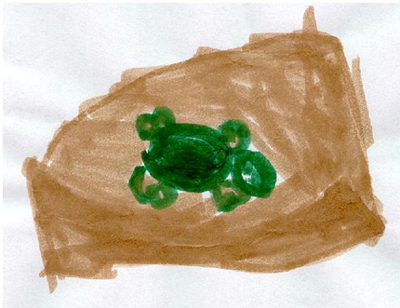 Figure 1. This drawing shows George digging under her food dish.
Figure 1. This drawing shows George digging under her food dish.
What Happened:
When the AM class came in, George was partly buried in her wood shavings.What We Thought and Said:
"George is trying to make a nest."
"George is going to have babies."
"It is colder. We put on our coats. Maybe George is cold."
"He’s digging in the chips to get warm."
"She was digging because she was too cold!" (Fig. 2)
 Figure 2. In this drawing, George is digging because she was cold.
Figure 2. In this drawing, George is digging because she was cold.
What We Tried:
"We dug our hands into the shavings and into the sand to see if it was warmer." (Some said yes; some said no.)
"Aaron made a house out of paper for George. George went in." (Fig. 3)
 Figure 3. Aaron made a house out of paper. This drawing
by Joe is of George in the house that Aaron made.
Figure 3. Aaron made a house out of paper. This drawing
by Joe is of George in the house that Aaron made.
What Happened:
The teacher brought in a log with a hole. George went into the log. George had to be awakened when it was bath time. George wasn’t going to the bathroom in her tub anymore.What We Thought and Said:
"George spends most of her time way inside the log and a little buried."
"George must have been cold and wanted to get warmer."
"The inside of the log was cozy and darker and warmer."What We Tried:
We looked in the book about turtles that we read earlier in the year.
The children unanimously shouted, "George is hibernating!" (Fig. 4)
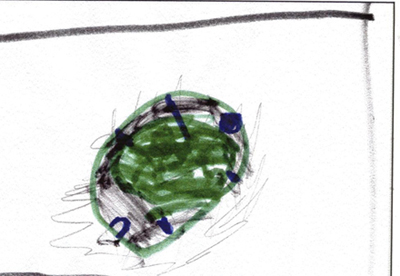 Figure 4. In this drawing, George is inside the log; she is hibernating.
Figure 4. In this drawing, George is inside the log; she is hibernating.
This very brief documentation of a small part of the Turtle Project provides evidence that the children in this kindergarten classroom are well on their way to achieving the kindergarten equivalent of science content standard A, developing the "abilities necessary to do scientific inquiry." The documentation shows how children are learning to ask questions about organisms and events in the environment and to plan and conduct a simple investigation. The children's words and drawings could also be collected for documentation of individual children's achievement of the content standard. These could be placed in individual portfolios. If performance standards were available, that is, criteria and standards of what would be considered "good" questions or observations, the children's work could be examined to document the attainment of those performance standards.
Many teachers will find on examining recommended standards in other areas, such as literacy and mathematics, that children are also achieving these standards through project work or other engaged learning experiences. As teachers become familiar with content standards or curriculum areas that they are required to address, they can incorporate the documentation of the achievement of these standards into their planning.
Documenting Young Learners’ Knowledge, Skills, and Dispositions
Teachers can carefully and systematically collect information about the knowledge, skills, and dispositions developed during the early years and reflect upon this information. Documentation of children’s actual performance is an alternative to traditional methods of assessment, such as standardized group-administered tests. Tying that documentation to state or national standards enables the teacher to evaluate the child’s progress and make critical decisions about curriculum, classroom materials, and personal interactions. These decisions can help move the child to greater competency and assist in reaching levels of development specified in the standards.
Documentation is defined as "providing evidence" (Helm, Beneke, & Steinheimer, 1998). The evidence of children’s learning in prekindergarten through third-grade classrooms can include combinations of the following:
- Individual Portfolios
- Individual or Group Products
- Teacher Observations
- Child Self-reflections
- Narratives of Learning Experiences
Table 1 shows how these types of documentation can be collected in classrooms for young children (adapted from Helm, Beneke, & Steinheimer, 1998). The key is to provide "authentic" evidence of the young learner’s growing competencies. According to Wiggins (1990, p. 1), "Assessment is authentic when we directly examine student performance on worthy intellectual tasks."
| Type of Documentation | Collection Method |
|---|---|
I. Individual Portfolios |
Specific content area items collected at specific intervals, for example, writing samples; record of problem solving using numbers; unique items that show learning style, interests, unique talents of individual children An example of an individual portfolio item is Baxter's labeling of his vegetable drawings. 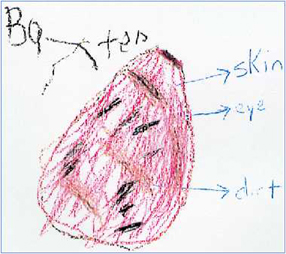 Drawing 1. The
teacher needed to label this drawing for Baxter on April 26. Drawing 1. The
teacher needed to label this drawing for Baxter on April 26.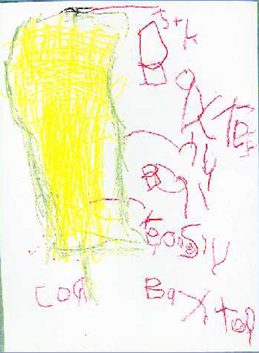 Drawing 2: Baxter's
ability and disposition to label his own
vegetable drawings begins to emerge in his labeling of an ear of corn on May
2. Drawing 2: Baxter's
ability and disposition to label his own
vegetable drawings begins to emerge in his labeling of an ear of corn on May
2.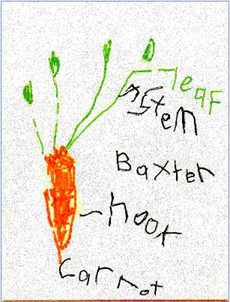 Drawing 3: Baxter's
was able to proficiently copy
the labels for his drawing of a carrot on May 10. Drawing 3: Baxter's
was able to proficiently copy
the labels for his drawing of a carrot on May 10. |
II. Products |
Products that children make or produce such as spoken language as collected in anecdotal notes or audio/visual tapes; written language as collected in signs, captions to photos, drawings, letters, labels, and child-made books; constructions such as play environments, Lego, or block structures; drawn pictures or paintings; records of data collection; musical expressions such as made-up songs or dances; records of vocabulary or concepts learned such as webs and lists of words An example of a group product is the boiler constructed by 3- and 4-year-olds.
|
III. Observations |
Observations made by the teacher and recorded as specific knowledge or skills on a developmental checklist or curriculum guide; anecdotal notes on events indicating knowledge, skills, or dispositions; behavioral indicators of dispositions (expression of interest, time spent on activities, self-selection of activities) An example of an observation is this description of tallying during the Fire Truck Project.This was the children's first experience with the tally graph. We had graphed several times before doing a picture graph and a bar graph. But this was the first time they'd used tally graphs. The children spent at least 10 or 15 minutes graphing the parts of the fire truck that they had asked about on their web. I made a graph for them with a picture of a tire and a column for them to make their tally marks, and a picture of the windows, etc. They took the clipboards and just walked around the fire truck, placed a mark for each object they saw, then counted their marks. They, for the most part, were very successful. They really enjoyed the counting as the numbers got higher and higher. "There are eight windows on this fire truck!" They were amazed! They started to count the hoses. The firefighter said, "Oh, I'm going to have to bring them down. There are a lot of hoses on this fire truck!" As their counting grew, they just got more and more excited about putting those tally marks on the paper the right way.This observation by Pam Scranton was taken from her notes about the Fire Truck Project in her prekindergarten classroom at Woodford County Special Education Association in Eureka, Illinois. |
| IV. Child Self-reflections | Children’s statements of understanding their own preferences of activity, enjoyment, or interest in content areas; pride in accomplishment; acceptance of need for persistence and hard work. An example of a child's self-reflection is Taylor's comment on his building.This reflection was documented by Judy Cagle in her pre-primary classroom at Valeska Hinton Early Childhood Education Center and appears in Windows on Learning: Documenting Young Children's Work (Helm, Beneke, & Steinheimer, 1998, pp. 26-27). |
| V.
Narratives of Learning Experiences |
Stories of learning experiences of individuals, small groups, or the whole class in
The turtle story presented earlier is an example of a narrative. |
| *Adapted from Helm, Beneke, & Steinheimer (1998, p. 36). | |
Documenting how young children meet standards in this way requires careful thought and consideration. Which standards lend themselves to being documented easily through teacher observations? What knowledge and skills that demonstrate achievement of standards might children reveal in the course of working on a long-term investigation such as a project? Might some children demonstrate knowledge of concepts in one way, such as constructing a model, while other children show the same mastery of knowledge through writing a book about what they learned?
Guidelines for Matching Documentation to Standards for Young Learners
Linking assessment and teaching in the early years requires that the teacher plan, during learning experiences, to acquire documentation (or evidence) that will demonstrate the achievement of standards or curriculum requirements. Here are some guidelines to assist teachers in this planning:
- Plan your documentation and assessment process to take advantage of natural outcomes of routine classroom activities.
- Provide for children’s individual learning styles.
- Consider the natural products of learning experiences.
- Document progress toward standards, not just attainment of them.
Many routine classroom activities provide opportunities to document young children's performance related to standards. Gathering informative documentation does not require a specially orchestrated event. For example, many teachers include journal writing as part of their daily routine. Children, independently or in small groups, write or draw on self-chosen topics. The goal is usually to encourage expression of thoughts in writing, rather than demonstrate correct spelling, punctuation, and grammar. Yet, as students’ skills develop, evidence is seen in their writing of their new knowledge of conventions of written language. Saving or copying selected pages from children’s journals can provide documentation of progress toward language arts standards.
Other possible classroom routines that may provide documentation related to standards include daily oral language, oral math, sustained silent reading, partner reading, science experiments, science observations, literature extension activities, math manipulative activities, and long-term studies or projects in all content areas. Routine classroom activities provide integral, connected, and natural ways to document children’s performance related to standards.
A challenge for teachers of young learners is the range of skills and competencies as well as the variety of ways that young learners demonstrate them. To get the most accurate assessment of each child’s knowledge, skills, and dispositions, teachers must know their students well. For example, a teacher might ask: Is this child better at writing about his or her knowledge of science processes or talking about it? Would I learn more about this child's progress in meeting this standard if he or she constructed something as a model or demonstrated a process to others? Would a musical expression or an opportunity for dramatic interpretation be more appropriate for this child? Matching documentation method to the learning style of the child insures that the child’s performance represents what he or she knows and can do.
Children’s developing writing skills are easily documented by collecting actual writing samples. Knowledge, skills, or dispositions about writing can be assessed by looking at children's work.
Prekindergarten, kindergarten, and first-grade students demonstrate their growing math knowledge when using problem-solving strategies with real objects. Effective documentation of math skills need not be worksheets or timed practice tests but might be teacher observations of children's work with manipulatives. Quoting children’s comments about their mathematical understanding in the course of working with these objects or manipulatives could be very informative.
Teachers have much to gain from collecting ongoing documentation, rather than waiting for final attainment of those standards. In this way, the evidence will be available to show the progress that children are making toward a standard. Documenting the growth process enables the teacher to adjust and improve instruction. For example, teacher-edited, final published versions of children’s writing are less informative than collections of children’s writing that include first drafts, first edits, and the final edited version. The latter demonstrate children's growth in their understanding of self-expression, their spelling, and their developing mastery of grammar in the writing process. The teacher can then plan lessons and activities to help children develop the skills that the collected pieces of work indicate the children lack.
Documenting children’s progress toward standards rather than just attainment of standards also fits better with in-depth investigation and inquiry in integrated approaches such as the Project Approach. As children engage in a long-term study, documentation of their progress toward several standards becomes more feasible. In a study of transportation, children may study transportation now and in times past. Children will be working toward standards in history as they compare and contrast phenomena in different time periods, science as they analyze engines and speeds, mathematics as they organize data about wheels and seating capacity, and language arts as they investigate and represent their findings through writing or oral presentations. In long-term investigations and studies, displays, drawings, written work, and narratives of experiences will provide many pieces of documentation to show progress toward a variety of standards.
A Recommended Decision-making Process
To assist teachers in integrating documentation toward standards in classrooms for young children, a decision-making process was developed. This process is embedded in the natural flow of teacher planning of learning experiences.
In the decision-making process, the teacher becomes aware of a standard and then generates a list of knowledge, skills, and dispositions that are implied by this standard. With an understanding of how young children learn and represent their learning, the teacher then asks, "If my students reach this standard, how might they show it in my classroom?" This list could include children's drawings, comments, behaviors, constructions, written work, or child-made displays that demonstrate achievement of the standard. Next, the teacher considers ways to set up the classroom environment and plans the learning experiences to enable children to achieve the standard and also show that achievement.
As plans develop, the teacher considers the types of documentation that might be gathered and prepares for collection. Specific plans may be made for portfolio collection, observations, products, self-reflections, or narratives of experiences. These can vary from child to child. The teacher then teaches, observes, and collects documentation in the classroom. Reflecting on the knowledge, skills, and dispositions inherent in the standard during the process of collection enables the teacher to assess the adequacy of the documentation to provide evidence of progress toward this specific standard. The teacher can plan for additional collection if necessary.
The final step involves evaluating the documentation as it is collected. Did the students make sufficient progress? If necessary, the teacher revises and adjusts the learning experiences to maximize the opportunity for all children to reach the standard. This decision-making process can be viewed step by step as a teacher would think through the process (PowerPoint slide show) or in its entirety as a flowchart.
Conclusion
The challenges of the assessment of young children' growth, development, and learning can be overcome by integrating documentation of standards into the planning of classroom experiences. Teachers can teach in ways that young children learn best, can provide critical experiences for intellectual growth, and can assess that growth at the same time. Standards can become a part of classrooms for young learners, and the process can become a natural part of active, engaged teaching and learning.
References
Bredekamp, Sue (Ed.). (1987). Developmentally appropriate practice in early childhood programs serving children from birth through age 8 (Exp. ed.).Washington, DC: National Association for the Education of Young Children.
Bredekamp, Sue, & Copple, Carol (Eds.). (1997). Developmentally appropriate practice in early childhood programs serving children from birth through age 8. (Rev. ed.). Washington, DC: National Association for the Education of Young Children. ED 403 023.
Bruner, Jerome. (1996). The culture of education. Cambridge, MA: Harvard University Press. ED 401 263.
Caine, Renate Nummela, & Caine, Geoffrey. (1997). Education on the edge of possibility. Alexandria, VA: Association for Supervision and Curriculum Development. ED 408 654.
Helm, Judy Harris; Beneke, Sallee; & Steinheimer, Kathy. (1998). Documenting young children's work: Windows on learning. New York: Teachers College Press. ED 421 217.
Helm, Judy Harris, & Katz, Lilian G. (in press). Young investigators: The project approach in the early years. New York: Teachers College Press.
Jensen, Eric. (1998). Teaching with the brain in mind. Alexandria, VA: Association for Supervision and Curriculum Development.
Katz, Lilian G. (1987). Early education: What should children be doing? In Sharon Lynn Kagan (Ed.), The care and education of America's children: Obstacles and opportunities. 90th Yearbook of the National Society for the Study of Education (Part I, pp. 50-78). Chicago: National Society for the Study of Education.
Katz, Lilian G., & Chard, Sylvia C. (1989). Engaging children's minds: The project approach. Norwood, NJ: Ablex. ED 407 074.
Labinowicz, Ed. (1980). The Piaget primer: Thinking, learning, teaching. Menlo Park, CA: Addison-Wesley.
National Committee on Science Education Standards and Assessment, National Research Council. (1996). National science education standards. Washington, DC: Author.
Smith, Frank. (1990). To think. New York: Teachers College Press.
Wiggins, Grant. (1990). The case of authentic assessment. ERIC Digest. Washington, DC: ERIC Clearinghouse on Tests, Measurements, and Evaluation. ED 328 611.
Author Information
Judy Harris Helm (Ed.D.) began her career teaching first grade. She then taught 4-year-olds, directed and designed early childhood programs, and trained teachers. Dr. Helm served on the task force for the design of the Valeska Hinton Early Childhood Education Center and was professional development coordinator for the school. She now assists other early childhood and primary schools in integrating research and new methods through her consulting and training company Best Practices, Inc. Dr. Helm is a national faculty member for the Work Sampling System and past state president of the Illinois Association for the Education of Young Children. She is coauthor with Sallee Beneke and Kathy Steinheimer of Windows on Learning: Documenting Young Children’s Work and Teacher Materials for Documenting Children's Work. She is coauthor with Dr. Lilian Katz of Young Investigators: The Project Approach in the Early Years, which will be released in November 2000.
Judy Harris Helm
10109 Fox Creek Dr.
Brimfield, IL 61517
Telephone: 309-446-3322
Fax: 309-446-3322
Email: bestpracticesinc@att.net
Gaye Gronlund (M.A.) is an early childhood education consultant from Indianapolis. A former preschool, kindergarten, and primary teacher, she now works with schools and programs around the country helping them implement developmentally appropriate curricular practices and authentic assessment procedures. Ms. Gronlund is a faculty member online for Pacific Oaks College, a staff development specialist for Teaching Strategies, and has been a national faculty member for the Work Sampling System. She has co-written a new book with Bev Engel called Focused Portfolios in Early Childhood Programs, now available in a self-published version, with another version from Redleaf Press available in fall of 2001.
Gaye Gronlund12005 Watermark Ct.
Indianapolis, IN 46236
Telephone: 317-823-8860
Fax: 317-823-8698
Email: GLGronlund@aol.com


